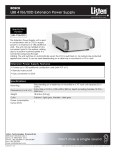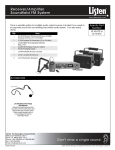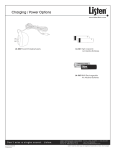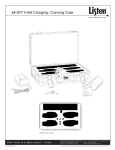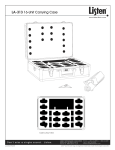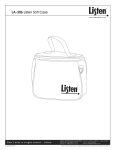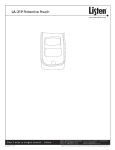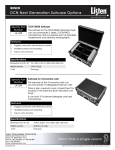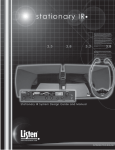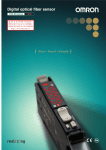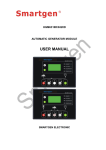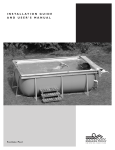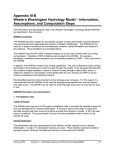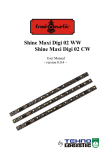Download User Manual - Listen Technologies
Transcript
User Manual Installation and Operation LR-42 Stethoscope 4-Channel Receiver LR-44 IR Lanyard 4-Channel Receiver LA-350 8-Unit IR Receiver Charging/Storage Station LA-351 8-Unit IR Receiver Storage Station © 2015 Listen Technologies Corporation® All Rights Reserved For further details regarding use, adjustment, or programming of your Listen Technologies products visit our website at www.listentech.com/support-manuals or contact us at +1.801.233.8992 or 1.800.330.0891. l 1 Stationary IR Receivers Table of Contents 2 l LR-42/LR-44 4-Channel IR Receivers Specifications LR-42 Quick Reference Page LR-44 Quick Refe rence Page Setup Instructions Operating Instructions Locking Instructions Programming Instructions Programming Examples Programmable Features Detailed Descriptions Accessories for LR-42/LR-44 4 6 7 8 12 18 19 24 27 28 LA-350/LA-351 8-Unit IR Receiver Storage/Charging Cases LA-350 Specifications and Features LA-351 Specifications and Feature LA-350 Charging Requirements/Instructions Cord Tidy Rack 31 32 33 36 Supplementary Information Troubleshooting Frequently Asked Questions Compliance Information Warranty Contacting ListenTechnologies 37 38 39 39 39 LR-42/44 Package Contents • LR-42 IR Stethoscope 4-Channel Receiver (or) LR-44 IR Lanyard 4-Channel Receiver • Quick Reference Card 11 22 33 LR-42 44 11 22 33 44 LR-44 Listen Part Number • LR-42 • LR-44 l 3 LR-42 IR Stethoscope Receiver Specifications Architectural Specification The IR stethoscope receiver shall be capable of receiving on four carriers (2.3, 2.8, 3.3, 3.8 MHz) and the channel shall be displayed on one of four front panel LEDs. The receiver shall be capable of being locked on a channel. The receiver shall be capable of receiving a stereo signal on each of the four carriers. The receiver shall have a SNR of 60 dB or greater and have built in squelch control. The device shall have an audio frequency response of 63 Hz to 15 kHz, +/- 3dB and shall have distortion of less than 2%. The device shall operate for 30 hours with two AAA alkaline batteries and 15 hours with two AAA NiMH rechargeable batteries. The receiver shall be covered by a limited lifetime warranty. The LR-42 is specified. Specifications RF LR-42 Carrier Frequencies Selectable: 2.3 MHz, 2.8 MHz, 3.3 MHz, 3.8 MHz Number of Channels Four (4) selectable channels IR Detectors Two (2) detectors under front IR lens Sensitivity One (1) nW/cm2 at 40 dB SNR Frequency Accuracy +/- .005% stability 0 to 50C Squelch Automatic on loss of RF signal (40 dB SNR) Compliance FCC Part 15, Industry Canada, CE, RoHS ** All system specifications are wireless end-to-end Audio Controls Indicators Power Physical Environmental System Frequency Response 63Hz - 15kHz (+/- 3dB) System Signal to Noise Ratio (A-weighted) Mono: >60dB System Distortion <2% total harmonic distortion (THD) Audio Output Jacks 3.5 mm connector unbalanced, mono or stereo headphones Audio Output Power 20 mW maximum at 32 ohms User Controls Volume, Power, Channel Select Programming Channel Lock, Auto Seek, Channel Lock-Out, Squelch Unit Power Indicated by current channel selection LED Channel Selection Red LED illuminates on the current channel selection Battery Type Two (2) AAA alkaline batteries or NiMH battery pack Battery Life 30 hours alkaline, 15 hours NiMH rechargeable pack (LA-364) Battery Charging Up to 9 hours, Fully Automatic with NiMH battery pack and LA-350 charger Dimensions (H x W x D) 1.8 x 4.0 x .75 in (46x102x19 mm) Stethoscope Arm length 8 in (203 mm) Color Grey with White Silk Screening Unit Weight without batteries 1.75 oz. (49 g) Unit Weight with batteries 2.55 oz. (74 g) Shipping Weight 8.00 oz. (227 grams) Temperature - Operation -10 C (14 F) to +40 (104 F) Temperature - Storage -20 C (-4 F) to +50 (122 F) Humidity Stereo: >52dB 0 to 95% relative humidity, non-condensing •Specifications are subject to change without notification. 4 l LR-44 Lanyard IR Receiver Specifications Architectural Specification The Lanyard IR Receiver shall be capable of receiving on four carriers (2.3, 2.8, 3.3, 3.8 MHz) and the channel shall be displayed on one of four front panel LEDs. The receiver will accept mono or stereo earphones with a 3.5 mm connector. The receiver shall be capable of being locked on a channel. The receiver shall be capable of receiving a stereo signal on each of the four carriers. The receiver shall have a SNR of 60 dB or greater and have built in squelch control. The device shall have an audio frequency response of 63 Hz to 15 kHz, +/- 3dB and shall have distortion of less than 2%. The device shall operate for 30 hours with two AAA alkaline batteries and 15 hours with two AAA NiMH rechargeable batteries. The receiver shall be covered by a limited lifetime warranty. The LR-44 is specified. Specifications Carrier Frequencies RF LR-44 Selectable: 2.3 MHz, 2.8 MHz, 3.3 MHz, 3.8 MHz Number of Channels Four (4) selectable channels IR Detectors Two (2) detectors under front IR lenss Sensitivity One (1) nW/cm2 at 40 dB SNR Frequency Accuracy +/- .005% stability 0 to 50C Squelch Automatic on loss of RF signal (40 dB SNR) Compliance FCC Part 15, Industry Canada, CE, RoHS ** All system specifications are wireless end-to-end Audio Controls Indicators Power Physical Environmental System Frequency Response 63Hz - 15kHz (+/- 3dB) System Signal to Noise Ratio (A-weighted) Mono: >60dB System Distortion <2% total harmonic distortion (THD) Audio Output Jacks 3.5 mm connector unbalanced, mono or stereo headphones Audio Output Power 20 mW maximum at 32 ohms User Controls Volume, Power, Channel Select Programming Channel Lock, Auto Seek, Channel Lock-Out, Squelch Unit Power Indicated by current channel selection LED Channel Selection Red LED illuminates on the current channel selection Battery Type Two (2) AAA alkaline batteries or NiMH battery pack Battery Life 30 hours alkaline, 15 hours NiMH rechargeable pack (LA-364) Battery Charging Up to 9 hours, Fully Automatic with NiMH battery pack and LA-350 charger Dimensions (H x W x D) 1.80 x 4.00 x 0.75 in. (46 x 102 x 19 mm) Color Grey with White Silk Screening Unit Weight without batteries 1.75 oz. (49 g) Unit Weight with batteries 2.55 oz. (74 g) Shipping Weight 8.00 oz. (227 g) Temperature - Operation -10 C (14 F) to +40 (104 F) Temperature - Storage -20 C (-4 F) to +50 (122 F) Humidity Stereo: >52dB 0 to 95% relative humidity, non-condensing •Specifications are subject to change without notification. l 5 LR-42 Quick Reference Stetho Arms (LR-42 model only): Speakers located in ends of stetho arms, place in ears to listen to audio Channel Indicator LEDs: Displays which channel the unit is currently tuned to. Also can display battery level, etc. Volume Control Dial: Use to adjust volume level in speaker(s) Power Button: Press to turn unit on, press and hold to turn unit off 6 l 1 2 3 4 IR Receiver Lens: Lens covers the IR receiving components, ensure entire lens is visible during use Select Button: Press to change the channel, also used with programming function 1 LR-44 Quick Reference Lanyard (LR-44 model only): Holds receiver in place below chin of wearer Channel Indicator LEDs: Displays which channel the unit is currently tuned to. Also can display battery level, etc. Volume Control Dial: Use to adjust volume level in speaker(s) 1 2 3 4 Power Button: Press to turn unit on, press and hold to turn unit off Lanyard Adjustment Ball (LR-44 model only): Adjust the loop size of the lanyard by pulling on this ball (usually done after unit is on user’s body) IR Receiver Lens: Lens covers the IR receiving components, ensure entire lens is visible during use Select Button: Press to change the channel, also used with programming function Headset Jack (LR-44 model only): Accepts any earpiece with a 3.5 mm TRS connector l 7 Model: 4-Channel IR Receiver FCC: This device complies with Part 15 of the FCC Ru IC: This Class A digital apparatus complies with Canad Listen Support: 800.330.0891 801.233.8992, www.listentech.com LR-42/44 Setup Instructions 1 Unpack the Product 2 Determine Battery Type to be Used Remove outer packaging and plastic cover. Verify all components are present and that no physical damage has occurred to the product. 2A Alkaline Batteries: If using alkaline batteries install them in alkaline battery compartment attached to rear of unit using the following process (purchase Listen Technologies part number LA-363). 1 Remove alkaline battery compartment Press down on compartment and push towards the bottom of unit. Model: 4-Channel IR Receiver FCC: This device complies with Part 15 of the FCC Rules. IC: This Class A digital apparatus complies with Canadian ICES-003. Listen Support: 800.330.0891 801.233.8992, www.listentech.com Model: 4-Channel IR Receiver FCC: This device complies with Part 15 of the FCC Rules. IC: This Class A digital apparatus complies with Canadian ICES-003. Listen Support: 800.330.0891 801.233.8992, www.listentech.com Model: 4-Channel IR Receiver FCC: This device complies with Part 15 of the FCC Rules. IC: This Class A digital apparatus complies with Canadian ICES-003. 2 Open battery compartment Listen Support: 800.330.0891 801.233.8992, www.listentech.com Open by pulling into two pieces using the grips on the top of the compartment. Grips 3 Install batteries 1 2 3 4 Insert two AAA alkaline batteries in compartment noting polarity. Model: 4-Channel IR Receiver FCC: This device complies with Part 15 of the FCC Rules. IC: This Class A digital apparatus complies with Canadian ICES-003. Listen Support: 800.330.0891 801.233.8992, www.listentech.com Model: 4-Channel IR Receiver FCC: This device complies with Part 15 of the FCC Rules. IC: This Class A digital apparatus complies with Canadian ICES-003. 4 Listen Support: 800.330.0891 801.233.8992, www.listentech.com Close battery compartment Snap the two compartment pieces back together. 1 5 2 3 4 Return battery compartment to rear of receiver. Place battery compartment on rear of receiver. 8 l 1 2 3 4 LR-42/44 Setup Instructions 2B Rechargeable NiMH batteries: To use rechargable NiMH batteries in the receiver you will need to purchase an NiMH rechargeable battery pack, Listen Technologies part number LA-364. IMPORTANT: D o not install AAA NiMH batteries in included alkaline battery pack, because the batteries will not charge in this pack; only use a Listen Technologies provided sealed battery pack (LA-364) for battery charging. Install LA-364 battery pack using the following process: 1 Remove alkaline battery compartment Remove alkaline battery compartment by pressing down on compartment and pushing towards the bottom of unit. Store alkaline battery pack for later use if desired. Model: 4-Channel IR Receiver FCC: This device complies with Part 15 of the FCC Rules. IC: This Class A digital apparatus complies with Canadian ICES-0 Model: 4-Channel IR Receiver FCC: This device complies with Part 15 of the FCC Rules. IC: This Class A digital apparatus complies with Canadian ICES-003. Listen Support: 800.330.0891 801.233.8992, www.listentech.com Listen Support: 800.330.0891 801.233.8992, www.listentech.com 2 Place LA-364 battery pack in receiver Place LA-364 battery pack in receiver. The unit will now recognize the rechargeable batteries and charge them correctly when unit is placed in a charging case (LA-350). Model: 4-Channel IR Receiver FCC: This device complies with Part 15 of the FCC Rules. IC: This Class A digital apparatus complies with Canadian Model: 4-Channel IR Receiver FCC: This device complies with Part 15 of the FCC Rules. IC: This Class A digital apparatus complies with Canadian ICES-003. Listen Support: 800.330.0891 801.233.8992, www.listentech.com Listen Support: 800.330.0891 801.233.8992, www.listentech.com 2 1 3 4 To charge, refer to charging section. 1 2 3 4 l 9 LR-42/44 Setup Instructions 3 Connect an Earphone or Headset (LR-44 model only) An earphone or headset will connect to the jack on the bottom of the unit. Either mono or stereo connectors may be used with Listen Technologies receivers. Make sure to push the connector all the way into the jack. 3 4 2 1 1 24 3 3 4 2 1 3 4 2 1 4 3 Turn Unit On Turn the unit on by pressing either button on the front of the unit. ATTENTION 1: The LR-44 model must have a headset connected to the unit to turn on and remain on for longer than ten seconds. ATTENTION 2: If using a new LA-364 NiMH battery pack the batteries may need to be put through one charge cycle before they will turn the unit on. 1 2 3 4 1 1 2 3 4 2 1 3 24 3 4 1 2 3 4 1 10 l 2 3 4 LR-42/44 Setup Instructions 5 Select a Channel and/or Program Channel Selection Method The Select button is used to change the channel. Press the button once to change the channel. The unit will either seek or scroll through the channels depending upon which channel selection method you have enabled. See below for description of possible channel selection methods. 5A Upon Power up When set to factory defaults the unit will turn on to the last channel is was tuned to upon power up. However, the unit can be programmed to continuously seek for a channel with signal upon power up until one is found (Auto-Seek). See page 19 for more programming information. 5B Single Channel Systems If you know what channel the unit will be used on, and you know that there is only one channel that the unit will need to be used on, you can lock it onto that channel now. See page 18 for channel lock information. 5C Multiple Channel Systems In systems that require the receivers to be able to access more than one channel you must decide which type of channel selection method you want enabled. The default setting is that each time you press the Select button the unit will scroll to the next channel. If you want the receiver to automatically begin seeking for another channel when the signal is lost (such as walking from room to room in a museum) the Auto-Seek function must be enabled. See page 19 for more information. 6 Select Stereo/Mono Mode If the receiver will be receiving a mono signal (stereo mode is not enabled on LT-82) no action is required as Mono Mode is the default setting. However, if the receiver will be receiving a stereo signal the receiver must be set to Stereo Mode to function properly. 7 Setup Additional Programming (if desired) Additional programming options, in addition to the Auto-Seek and Stereo/Mono Mode functions described above, are the Channel Lock-out and Squelch setting. See page 19 for a complete explanation of the programming functions for the receiver. l 11 LR-42/44 Operating Instructions NOTE: The following operating instructions briefly describe how a unit operates based on which programming features have been enabled/disabled, with the factory default settings highlighted. See page 19 for detailed information about programming and operating units using non-default settings. 1 Connect an Earphone or Headset (LR-44 Model Only) An earphone or headset will connect to the jack on the bottom of the unit. Either mono or stereo connectors may be used with Listen Technologies receivers. Make sure to push the connector all the way into the jack. 3 4 1 2 1 3 24 3 1 2 4 3 4 1 2 2 Position the Unit on User’s Body ATTENTION: If desired, this step can be done after turning the unit on and selecting a channel as long as the front of the receiver is not obstructed during the channel selection process. IMPORTANT: A lways wear the receiver in such a way that there is nothing covering the front lens of the receiver. If the front lens is covered or obstructed the receiver will have very poor range. 12 l 3 LR-42/44 Operating Instructions 2A LR-42 Position the receiver so the stethoscope arm tips rest in the ear holding the unit below the chin of the user. 2B LR-44 Position the lanyard around the neck holding the unit below the chin of the user. If desired, pull on the lanyard adjustment ball to decrease the size of the lanyard loop (bringing the unit closer to the user’s chin). To increase the size of the lanyard loop pull on the lanyard cord above the point it passes through the receiver. 1 2 3 4 1 2 3 4 1 l 2 13 3 4 LR-42/44 Operating Instructions 3 Turn the Unit On Turn on the unit by pressing either button on the front of the receiver. 1 2 3 4 1 1 2 3 2 1 3 24 4 3 4 1 2 3 4 1 2 ATTENTION 1: T he LR-44 model must have a headset connected to the unit to turn on and remain on for longer than ten seconds. ATTENTION 2: If using a new LA-364 NiMH battery pack the batteries may need to be put through one charge cycle before they will turn the unit on. 3A Auto-Seek Disabled (Default OFF) The unit will power up to the same channel that it was on when it was last turned off. 3B Auto-Seek Enabled The unit will power up to the same channel that it was on when it was last turned off. If no signal is present on that channel, it will seek for a channel with signal present. If none is found, it will continue seeking until it finds a signal. Note that if the unit has been locked on its channel, this lock will override Auto-Seek To turn the unit off press and hold the PWR button for 1.5 seconds. 14 l 3 4 1 LR-42/44 Operating Instructions 4 LED Sleep Mode 5 Select Listening Channel The receiver will shut off the channel indicator LEDs after a period of 10 seconds passes without any buttons being pressed. The receiver will still produce audio and the volume can still be adjusted, only the LEDs shut down. It will be necessary to “wake up” the receiver by tapping either the PWR or Select button before doing many of the operating tasks described in the next sections. Selecting Channel with: Auto-Seek Disabled (Default OFF) 5A 1 2 3 4 Press the Select button to scroll through the four channels. If the channel indicator LED flashes four times when Select is pressed, and the unit does not change channels, it is locked on the current channel. See page 18 for channel lock information. Also, if the unit “skips” over the desired channel it is because that channel has been locked out. See page 19 for more information about the programmable features. 1 2 1 3 24 3 4 1 1 2 2 3 3 1 4 4 1 2 2 3 3 4 4 5B Auto-Seek Enabled The unit will continuously seek for a signal until one is found and then it will stay on that channel. If the signal is not detected for a short time period, or the user presses the SEL button, the unit will seek for another signal and will keep seeking until a signal is detected. If, however, the unit is locked on the current channel this lock will “override” Auto-Seek and the unit will not change channels when the signal is lost. Also, if there are channels that have been locked out in the Channel Lock Out mode the Auto-Seek will not stop on these channels. See page 19 for more information. l 15 LR-42/44 Operating Instructions 6 Adjust Volume Level 2 1 3 3 1 4 4 1 7 2 3 4 2 3 4 2 3 4 2 3 4 2 3 1 to a comfortable level. Use the control dial on the top of the unit to adjust the volume 1 Checking Battery Level and Current Channel 7A Checking Battery Level 1 1 Tapping the power button will display the battery 1 level on the channel indicator LEDs.4 2 3 4 2 1 1 2 3 1 2 4 1 24 3 3 4 3 4 1 2 3 4 1 1 2 3 4 1 3 The battery level will then display on the channel indicator LEDs for two seconds (unless battery level is less than about 5%, in which first LED will flash for five seconds). Each lit channel indicator represents approximately 25% of the battery’s capacity. (see chart below). 4 22 33 44 22 33 44 1 22 33 44 1 2 3 4 1 1 1 1 1 1 l 4 3 1 16 4 When a battery check is initiated all four LEDs will turn on. Then the LEDs will ramp down to the current battery level. If all four LEDs turn on and remain on the batteries are full. LED off 2 3 3 2 LED on 1 2 2 1 1 2 2 2 3 3 3 2 3 2 3 Stereo Mode Channel Lock-Out Auto-Seek Squelch 4 4 Spare 4 4 Reset To Defaults Exit Program 1 2 3 LR-42/44 Operating Instructions 7B Checking Current Channel The channel the unit is currently on is represented by the corresponding LED in the channel indicator LEDs being lit (unless unit is in LED sleep mode). To check which channel the unit is on without changing the current channel while the unit is in LED sleep mode, press either the PWR or Select button once. This will turn the channel indicator LEDs back on for 10 seconds. 3 4 2 1 1 3 24 3 4 1 8 2 3 2 1 4 1 2 3 3 4 4 2 1 3 4 Auto Shut-Off Feature The receiver will automatically turn off in the two following situations: 9 1 After 10 seconds 2 After 30 minutes After 10 seconds if there is no headset plugged into the headset jack (LR-44 model only). This allows for a quick battery status check without having to plug in a headset. This function is also disabled while in Program Mode. 2 1 After 30 minutes if no signal is detected by the receiver (both models). Powering down the unit 2 To power down the unit press and hold the PWR button for 1.5 seconds. All of the LEDs will light up momentarily and then turn off signaling power has 2been shut3 off. 4 1 1 4 2 1 1 2 3 4 1 1 2 3 4 2 1 3 24 3 4 1 2 3 4 1 2 1 3 1 4 1 2 2 2 l 17 3 4 LR-42/44 Locking Instructions Locking the Receiver on One Channel The unit can be electronically locked on one channel so that it will not change channel even if the Select button is pressed. It is recommended to lock the receivers on the channel that is being used in systems that do not require the user to change channels (single channel systems). Channel Lock Procedure The unit can be electronically locked on the channel it is currently on using the following process. 1 Select the channel that you want to lock the unit on. 2 Wait until the unit enters LED sleep mode. LED sleep mode begins when the unit extinguishes the channel indicator LED which will happen 10 seconds after the last button is pressed. 3 Once in LED sleep mode, press and hold both the Select and Power buttons for three seconds. 4 After holding for three seconds, the channel indicator LED will flash once indicating that the unit has been successfully locked. Once the channel indicator LED flashes you can release the Power and Select buttons. Channel Unlock Procedure The procedure for unlocking the unit is the same as locking the unit. Lock Indicators If you press the Select button to change the channel when the unit is locked, the channel indicator LED will flash four times and the unit will not change channels. Follow the lock/unlock procedure shown above to be able to change the channel. 18 l LR-42/44 Programming Instructions Program Mode Overview The following features can be programmed within the program mode: Stereo On/Off, Channel Lock Out, Auto Seek and Squelch. The following sections outline the procedures required to enter the program mode, modify the programmable features and exit the program mode. There are also several examples of how to use the program mode to change the settings of the receiver. Lastly, the end of this programming section provides a detailed description about each programmable feature and when they can or should be used. Entering Program Mode 1 Make sure that the unit is off (not just in LED sleep mode). 2 Press and hold the Power and Select buttons for three seconds. 3 When program mode is entered all four LEDs will flash once indicating successful entry into program mode. 4 Immediately after the LEDs flash the channel one LED will come on. This represents the first of the programmable features, the Stereo On/Off function. While in Program Mode 1 The Channels 1, 2, and 3 LED indicators are used to display which programmable feature is currently selected. 2 1 1 2 1 3 24 3 3 4 4 1 2 3 4 1 1 2 3 2 3 4 4 1 2 3 4 2 The Channel 4 LED indicator shows whether the Stereo On/Off and Auto-Seek features are enabled or disabled. If the Channel 4 LED is on, these features are enabled. 3 Press the Select button to advance to the next program mode feature. 4 Press the Power button to: 1 2 3 4 4A Enable or disable the Stereo On/Off and Auto-Seek Features (or), 4B Enter the program “sub-mode” required to adjust the Channel Lock-Out and Squelch features. 1 2 3 4 1 1 1 1 2 3 4 2 3 4 2 3 4 2 3 4 l 19 LR-42/44 Programming Instructions Program Mode Functionality Diagram Use this chart to help with navigating through, and adjusting the features within, the program mode. Programmable Feature LED on Stereo On/Off 1 LED on LED off LED on LED off Channel Lock-Out LED on LED off LED on 2 LED on off LED 3 Auto-Seek LED off LED on LED off LED off 4 Squelch 5 No Function 6 Reset to Defaults Navigating within the Program Mode Receiver LED Display Shows 1 1 1 1 1 1 1 1 1 1 1 11 1 11 1 1 1 1 1 11 1 1 1 1 1 11 1 1 11 1 11 1 1 1 1 11 1 1 11 1 7 Exit Program Mode 1 Stereo Mode2 Advances to Feature Toggles Stereo On/Off. LED 4 illuminated indicates stereo is ON default : off 3 4 2 3 4 2 2 2 2 2 2 2 2 2 22 2 22 2 2 22 2 22 2 2 22 2 22 2 2 2 2 2 22 2 2 2 3 3 3 3 3 3 3 3 3 33 3 33 3 3 33 3 33 3 3 33 3 33 3 3 3 3 3 33 3 3 3 4 Stereo Mode Enters Channel Lock-Out 4 Channel Lock-Out Advances to Feature 3 “Sub-Mode” (See next page for 4 Stereo Mode instructions) Auto-Seek 4 4 Channel Lock-Out Stereo Mode 4 Auto-Seek 4 4 Channel Lock-OutToggles Auto Seek On/Off. LED 4 Stereo Mode Squelch 4 illuminated indicates 44 Auto-Seek to Feature 4 4Advances Channel Lock-Out Auto-Seek is ON Stereo Mode Squelch 44 4 default : off Auto-Seek Channel Lock-Out Spare 4 4 4 Squelch Auto-Seek 4 Channel Lock-Out Spare 44 Enters Squelch Adjustment 4 Squelch Auto-Seek Advances to Feature 5 “Sub-Mode” Reset To Defaults 4 4 4 Spare (See page 105) Squelch 4 Auto-Seek Reset To Defaults 44 4 Spare Squelch Exit Program 4 4 4 Reset To Defaults Spare 4 Squelch to Feature 6 No Function Exit Program 44Advances 4 Reset To Defaults Spare 4 4 2 22 2 2 Stereo Mode Channel Lock-Out Exit Program 3 33 3 3 Reset 4 SpareTo Defaults 44 Exit Program Reset To Defaults 4Advances to Feature 7 4 22 33 44 2 3 4 2 3 Exit Program Reset To Defaults Exit Program Returns to Feature 1 LED on 4 2 LED off 1 1 1 1 1 Unit flashes all LED’s 3 times indicating reset and then the unit shuts off Exit Program 1 LED off l Pressing the Power Button 2 LED on 20 Pressing the Select Button Exits Program Mode and returns to Stereo Mode mode 3standard operating 4 2 3 1 24 Stereo Mode 3 2 3 1 24 Auto-Seek Channel Lock-Out 3 2 3 1 24 Auto-Seek 3 Squelch 2 3 1 24 Squelch Spare 2 3 1 24 2 3 4 Channel Lock-Out 4 4 3 Spare 3 4 4 Reset To Defaults Reset To Defaults Exit Program l active) l active) l active) l active) l active) l active) l active) l active) l active) l active) l active) l active) l active) ll active) active) LR-42/44 Programming Instructions Channel Lock-Out “Sub-Mode” Instructions While in Channel Lock-Out “Sub-Mode” 1 The channels that would be available are represented by the corresponding channel indicator LED being on and the channels that would be “locked out” are represented by the channel indicator LED being off. 2 Press the Select button to advance to the next channel(s) active combination. 3 Press the Power button to save the selected channel(s) active combination and return to regular mode 0 (no squelch) 2 Auto-Seek 3 function (the thesquelch) selected feature). 4 will 0be(no 1 2 3 4 0 (no squelch) 1 2 3 0 (no squelch) 4 2 3 1 4 0 (no squelch) 1 2 3 4 1 0 (no squelch) 1 2 3 0 (no squelch) 4 1 1 2 3 2 3 0 4 Use this help with3 navigating through, and adjusting the channels active, within the Channel Lock-Out “Sub-Mode”. 1 chart to2 1 (no squelch) 4 1 2 3 4 1 0 (no squelch) 1 4 2 3 1 0 4 1 (no squelch) 2 3 1 4 0 (no squelch) within the Channel Lock-Out “Sub-Mode” 1 1 Navigating 22 33 2 0 (no squelch) 44 1 11 22 33 4 0 (no squelch) 2 2 Display 3 Shows: Receiver LED 4 1 11 2 3 4 0 (no squelch) 4 2 2 3 11 Pressing Pressing the Power Button 0 (no squelch)the Select Button 2 3 1 4 2 1 22 33 4 1 1 44 11 2 2 3 1 2 3 4 1 3 4 22 33 2 1 44 11 2 3 22 33 1 44 11 22 33 2 3 1 1 4 11 1 3 2 3 4 2 22 33 4 1 2 4 3 11 4 2 3 4 2 3 2 1 3 4 2 3 4 1 2 4 3 1 22 33 2 4 2 3 3 44 11 2 3 4 1 2 4 4 2 3 11 3 2 2 3 4 4 22 33 4 3 1 4 11 4 4 2 3 3 4 2 3 1 5 4 4 22 33 3 1 44 4 1 3 2 3 5 3 44 1 4 22 3 3 5 1 4 3 2 3 11 2 3 5 4 4 22 33 4 1 4 44 5 11 2 3 4 4 2 3 1 5 6 4 2 3 1 4 44 5 2 3 1 4 6 3 44 1 5 22 3 4 6 1 44 2 3 4 11 5 2 3 6 22 33 4 5 1 4 11 6 4 2 3 5 4 2 3 1 6 4 2 3 7 5 4 2 3 6 11 5 22 33 7 44 6 11 2 3 5 4 4 5 7 2 3 11 6 2 3 4 7 1 2 3 4 6 1 2 3 4 1 4 7 2 3 1 6 2 3 4 8 1 4 2 3 7 1 6 4 2 3 11 7 8 6 22 33 4 44 7 11 22 33 8 6 44 6 11 8 2 3 7 2 3 4 1 2 3 7 4 8 11 4 2 3 2 3 4 7 8 1 9 4 Advances to the next Saves the selected channel(s) active 2 3 1 7 8 4 2 3 11 22 33 9 7 8 44 11 22 33 4 channel(s) active combination and returns to regular 9 7 44 8 11 7 2 3 9 22 33 4 8 1 4 combination program mode 9 11 4 2 3 8 4 1 9 4 22 33 10 8 1 4 9 1 8 22 33 10 44 9 11 22 33 8 44 8 10 2 3 11 9 2 3 4 10 1 22 33 4 9 1 4 11 10 4 2 3 9 4 2 3 1 4 11 22 33 10 9 1 44 11 10 9 22 33 11 44 11 10 22 33 9 4 11 9 11 2 3 10 4 11 22 33 4 1 10 4 11 11 4 2 3 10 4 2 3 1 11 4 22 33 12 1 10 44 11 1 22 33 10 12 44 1 11 22 33 10 44 12 2 3 11 10 11 2 3 1 4 12 1 22 33 44 0 (no squelch) 1 11 2 3 11 12 4 2 3 4 11 1 4 2 3 1 2 3 4 12 13 11 4 11 2 3 12 11 13 44 1 22 33 12 11 0 (no squelch) 13 11 2 3 11 4 2 3 2 12 4 13 13 2 3 1 4 4 1 1 3 12 4 2 2 3 11 4 13 4 2 3 1 12 4 1 14 13 22 33 12 44 11 13 22 33 12 14 2 3 44 13 11 2 3 4 1 12 14 44 2 3 12 11 2 2 3 13 14 23 4 1 2 3 4 1 1 2 3 13 2 3 4 11 14 4 4 2 3 1 13 4 1 14 22 33 15 13 44 2 3 14 (tightest/lest range) 11 LED on (channel active) 2 3 13 4 15 44 14 (tightest/lest range) 11 22 33 2 13 44 15 range) 2 3 2 11 13 33 14 (tightest/lest 2 3 4 15 1 22 33 1 3 4 2 1 14 (tightest/lest range) 4 11 4 15 (tightest/lest range) 4 1 2 3 14 4 1LED off 22 LED on (channel active) 33 15 (tightest/lest range) 14 44 11 15 (tightest/lest range) 22 33 14 4 2 3 4 3 11 22 33 15 (tightest/lest range) 4 14 1 4 2 14 11 43 2 3 15 (tightest/lest range) 4 4 1 3 22 33 4 2 1 15 (tightest/lest range) 4 LED 4 11 4 1 2 3 off 15 (tightest/lest range) 4 21 1 2 3 15 (tightest/lest range) 4 1 2 3 15 (tightest/lest range) 4 4 1 2 3 15 (tightest/lest range) 4 Channel Lock-Out “Sub-Mode” Functionality Diagram Channels Active 1 2 1,2 3 1,3 2,3 1,2,3 4 1,4 2,4 1,2,4 3,4 1,3,4 2,3,4 1,2,3,4 (default) l LR-42/44 Programming Instructions Squelch Adjustment “Sub-Mode” Instructions While in Squelch Adjustment “Sub-Mode” 1 There are 16 available squelch settings. The 16 settings are represented by binary code (refer to the chart below). 2 Press the Select button to advance to the next possible squelch setting. 3 Press the Power button to save the selected squelch setting and return to regular program mode. Squelch Adjustment “Sub-Mode” Functionality Diagram Squelch Setting 0 1 2 4 5 6 7 8 9 10 11 12 13 15 22 l Tight Squelch (Least Range) 14 Loose Squelch (Most Range) 3 (default) No Squelch ve) ve) ve) ve) ve) ve) ve) ve) ve) ve) ve) ve) ve) ve) ve) ve) 0 (no squelch) 2 chart to 3 help with Use this through, and adjusting the channels active, within the Squelch Adjustment “Sub-Mode”. 4 navigating 0 (no squelch) 1 2 3 4 0 (no squelch) 1 2 3 0 (no squelch) 4 2 3 1 4 0 (no squelch) 1 2 3 4 1 0 (no squelch) 1 2 3 0 (no squelch) Navigating within the Squelch Adjustment “Sub-Mode” 4 1 Squelch 1 2 3 2 3 0 (no squelch) 4 1 1 Receiver LED Display Shows: 4 2 3 1 2 3 4 1 0 (no squelch) 1 4 Pressing the Select Button Pressing the Power Button 2 3 1 0 (no squelch) 4 1 1 2 3 4 0 squelch) 1 4 1 (no 22 33 2 1 0 (no squelch) 4 2 3 1 (no squelch) 11 22 33 0 2 44 1 (no squelch) 11 22 33 0 44 2 11 0 2 3 1 (no squelch) 4 2 2 3 4 1 2 3 1 (no squelch) 4 0 11 4 2 22 33 1 4 3 11 22 33 2 1 44 11 2 3 22 33 1 44 11 22 33 2 4 3 1 4 11 1 3 2 3 4 2 2 3 4 1 3 1 2 44 3 11 22 3 2 44 3 11 22 33 4 2 4 3 2 3 1 22 33 2 4 3 44 11 22 33 4 1 2 44 4 11 3 2 2 3 4 22 33 4 3 1 44 2 11 4 22 33 3 4 11 5 4 4 22 33 3 4 4 11 3 22 33 5 4 44 4 11 22 33 3 5 4 3 11 2 3 5 4 4 2 3 4 3 1 4 2 3 4 5 11 4 22 33 4 4 11 5 6 4 2 3 4 44 5 2 3 1 4 6 3 44 1 5 22 3 4 6 1 4 2 3 4 11 5 2 3 6 4 22 33 4 5 1 4 4 11 6 4 22 33 5 4 11 6 4 22 33 7 5 4 6 11 5 22 33 4 7 44 6 11 22 33 5 4 5 7 11 6 2 3 4 7 2 3 4 5 6 1 2 3 4 11 4 7 22 33 6 4 8 11 4 22 33 7 6 4 11 7 8 6 22 33 44 7 11 22 33 4 8 6 4 6 11 8 2 3 4 7 Saves the selected squelch 22 33 4 6 1 7 44 8 Advances to the next 11 22 33 7 44 8 setting and returns to 11 9 22 33 7 8 44 squelch setting 11 22 33 9 7 8 44 regular program mode 11 22 33 9 7 44 8 11 7 2 3 9 22 33 4 8 1 44 7 9 11 22 33 8 44 11 9 2 3 10 8 44 9 1 8 22 33 10 2 3 44 9 11 2 3 8 4 8 10 2 3 11 9 2 3 4 10 1 2 3 4 8 9 1 2 3 4 11 10 4 22 33 9 4 11 4 11 2 3 10 9 44 2 3 1 10 9 11 2 3 4 1 10 22 33 4 9 1 4 11 9 11 2 3 10 4 11 22 33 4 9 1 10 44 11 11 22 33 10 4 11 11 4 22 33 12 10 4 11 11 22 33 10 12 44 11 11 22 33 0 (no squelch) 10 44 12 2 3 2 3 11 10 4 11 2 3 4 4 12 1 2 3 1 4 1 11 10 4 2 3 11 4 12 22 33 11 44 11 2 3 12 13 11 4 1 2 3 12 11 0 (no squelch) 13 4 2 3 1 2 12 11 2 3 13 44 4 1 13 11 2 3 1 3 2 3 2 1 12 4 2 3 13 1 4 4 11 1 1 12 4 2 3 11 13 22 33 12 44 11 14 13 2 3 12 44 2 3 1 13 2 3 12 14 4 1 44 13 11 22 33 2 12 14 4 2 3 12 23 11 4 2 3 13 1 3 4 14 2 1 2 3 4 1 12 13 4 2 3 4 1 11 14 22 33 13 44 11 14 (tightest/lest range) 4 2 3 15 13 14 1 LED on 2(channel 3active) 44 13 15 2 3 4 1 14 (tightest/lest range) 22 33 2 4 13 1 4 15 range) 2 11 13 33 14 (tightest/lest 2 3 4 4 15 22 33 4 1 3 1 14 (tightest/lest range) 13 2 4 11 4 15 (tightest/lest range) 4 22 33 1 14 44 11 LED off 2 33LED on (channel active) 15 (tightest/lest range) 14 44 11 15 (tightest/lest range) 22 33 14 44 11 22 3 15 (tightest/lest range) 3 14 4 2 3 14 11 2 3 15 (tightest/lest range) 4 2 2 3 4 43 4 14 2 3 1 15 (tightest/lest range) 4 1 11 4 2 3 2 3LED off 4 4 15 (tightest/lest range) 1 1 2 3 15 (tightest/lest range) 4 1 2 3 15 (tightest/lest range) 4 1 2 3 15 4 1 15 (tightest/lest (tightest/lest range) range) 4 2 3 2 3 4 2 1 53 15 (tightest/lest range) 4 1 4 2 3 1 3 2 LR-42/44 Programming Instructions Resetting to Defaults 1 It is possible to reset the unit to factory default settings but the unit must be in the program mode to be reset. 2 While in program mode, select the “Reset to Defaults” function and press the power button. 3 The unit will flash the channel indicator LED’s three times and then shut down when reset. Exiting Program Mode There are two ways to exit the program mode 1 2 Wait 10 seconds without pressing a button (any changes made are saved). Use the Select button to scroll through the program mode functions until the “Exit Program Mode” function is selected and then press the Power button. l 23 Programming Examples Example #1 I want to turn on/off the Stereo Mode function and then exit program mode 1 Enter Program Mode (see page 19). 2 When program mode is entered the first function is active and the LED’s will show. LED on 1 2 3 4 Stereo Mode Using the functionality chart on a previous page note that this is the Stereo On/Off Function. LED off 2 Channel Lock-Out 3 3 4 Note that the channel 41LED indicates whether or not this function is on/off. 4 Press the power button to turn Stereo Mode on/off. 5 Exit Program Mode. 1 1 Example #2 2 3 4 2 3 4 2 3 2 3 Auto-Seek Squelch Spare 4 I want to turn on/off the1 Stereo Mode function and the Auto-Seek Function and then exit program mode. 1 4 Reset To Defaults 1 Enter Program Mode. 2 When program mode is entered the2first function LED’sProgram will show. 3 is active and theExit 4 1 LED on 1 2 3 4 Stereo Mode Using the functionality chart on a previous page note that this is the Stereo On/Off Function. LED off Channel Lock-Out 2 3 LED onthat the channel 41LED indicator Stereo Mode 4 not this 3 Note function is on/off. 2 represents 3 whether or 4 1 4 Press the power button to turn Stereo Mode on/off. 2 3 1 2 3 1 times until the LED’s show. Press the Select button two LED off 5 1 1 2 2 3 3 4 4 4 4 Auto-Seek Channel Lock-Out Squelch Auto-Seek Using the chart on a previous page note that this is the Auto-Seek Function. 1 4 Spare Squelch 7 Press the power button to turn Auto-Seek on/off. 2 3 8 Exit Program Mode. 1 1 1 l 3 3 4 Again, note that the channel is on/off. 1 4 LED indicates whether this function 1 1 24 2 2 6 2 3 4 4 2 2 3 3 4 4 2 3 4 Reset To Defaults Spare Exit Program Reset To Defaults Exit Program Programming Examples Example #3 1 2 3 4 0 (no squelch) I want to lock-out channels 2 2and 3 3using 4the 1Channel Lock-Out Function. 1 1 LED on (channel active) LED off 2 Enter Program Mode. 1 2 3 4 2 When program mode is entered the first function is active and the LED’s will show. LED on 1 2 1 3 2 4 3 3 Stereo Mode 4 Using the functionality chart on a previous page note that this 4 is the Stereo On/Off Function. LED off on LED 1 LED off 1 3 4 5 6 2 3 2 2 3 3 4 3 3 4 1 Press the Select button 1 once so the LED’s show. 2 1 1 3 2 2 Note that this is the Channel Lock-Out function. 2 3 4 1 Stereo Mode Channel Lock-Out 4 4 5 Channel Lock-Out Auto-Seek 4 4 6 Auto-Seek Squelch 2Channel Lock-Out 3 Press the Power button 1to enter the2 “Sub-Mode”. 3 4 4 1 7 2 “Sub-Mode” 3 Upon entry to the Channel Lock-Out the 4LED’s will show which channels are currently active 1 Squelch Spare (if the unit is at default settings, all four LED’s will be on indicating that all channels are active). 2 3 2 3 4 4 1 1 Press the Select button to scroll through the 15 possible combinations of active/locked out channels until 8 2 3 the unit displays. 4 1 2 2 1 1 1 3 3 2 3 2 Spare To Defaults Reset 4 4 4 9 Reset To Defaults Exit Program 3 7 4 1to save this2setting and3return to regular Press the Power button1 program mode. 4 10 8 Exit Program Mode. LED on Example #4 LED off 1 1 2 3 2 1 1 2 2 3 2 1 34 3 4 3 4 I want to reset the unit to factory defaults. 2 3 4 1 2 4 11 4 Stereo Mode Exit Program Channel Lock-Out 12 3 Auto-Seek 1 Enter Program Mode. 2 13 2 first function 3 4 When program mode is1entered the is active and the LED’s will show. LED on 1 1 11 2 2 2 3 3 4 Squelch 3 4 14 4 4 Stereo Mode Using the functionality chart on a previous page note that this is the Stereo On/Off Function. Spare 2 3 Channel Lock-Out 15 (tightest/lest range) 2 3 4 2 3 1 4 4 Press the Select Button 11 five times until the unit displays. LED off 3 1 1 22 3 3 4 4 Auto-Seek Reset To Defaults 4 Press the Power Button to reset the unit. 5 1 LED’s three2 times and then 3 shut4down. The unit will flash the four 4 It will be necessary to manually turn 1 the unit back on after a reset. 1 1 1 Squelch Exit Program 2 3 2 3 4 2 3 4 2 3 4 Spare Reset To Defaults Exit Program l 25 Programming Examples Example #5 1 2 3 4 0 (no squelch) I want to tighten the squelch setting to setting 10. 1 1 2 3 4 1 Enter Program Mode. 2 2 4 1 When program mode is1entered2the first 3function 4is active and the LED’s will show. LED on 2 Stereo Mode 3 LED on (channel active) LED on off LED LED off 1 11 2 2 2 3 3 3 4 1 1 1 2 2 2 2 3 3 3 3 4 4 LED on (channel active) Note that this is the Squelch Adjustment Function. 2 3 4 LED off 5 Channel Lock-Out Stereo Mode 8 2 4 4 Squelch Auto-Seek 6 3 7 2 3 4 the LED’s will show which squelch setting is 1 Adjustment “Sub-Mode” Upon entry to the Squelch 4 currently selected (if the1 unit is at2 default 3settings,4the unit will display representing a squelch setting five). Reset To Defaults Spare 1 7 5 Spare Press the Power button to enter 2the2 “Sub-Mode”. Squelch 3 Adjustment 2Squelch 3 4 3 4 1 1 4 1 1 6 4 1 1 1 2 2 2 2 3 3 3 4 3 2 3 4 8 4 4 5 Exit Program Reset To Defaults 2 4 1 3 163squelch 4 4 Press the Select button 11 to scroll 2through the settings until the unit displays. 6 2 3 4 1 10 Exit Program 2 2 3 3 4 11 4 7 2 3 4 Press the Power button 1to save this setting and return to regular program mode. Exit Program Mode 1 1 1 1 1 1 1 1 1 1 1 1 1 l 4 4 0 (no squelch) 2 3 4 1 Using the functionality chart on a previous page note that Stereo On/Off Function. 4 this is the Auto-Seek 2 2 3 3 4 LED off Channel Lock-Out 1 4 3 Press the Select button 1 1 three times2so the LED’s3show 1 4 2 3 4 1 1 26 3 9 2 3 4 2 3 4 2 3 4 2 3 4 2 3 4 2 3 4 2 3 4 2 3 4 2 3 4 2 3 4 2 3 4 2 3 4 2 3 4 11 8 12 9 13 10 14 11 15 (tightest/lest range) 12 13 14 15 (tightest/lest range) Programmable Features Detailed Descriptions Stereo Mode (Default is OFF) Stereo Mode Function This function must be set to match the type of signal that the receiver is receiving. If the receiver is receiving a mono signal this function must be OFF. If the receiver is receiving a stereo signal this function must be ON. When to enable Stereo Mode Stereo Mode must be enabled if the receiver is receiving a stereo signal from the transmitter. Channel Lock-Out (Default is All Channels Available) Channel Lock Out function This function is used to lock out channels from being accessible to the user when the Select button is pressed or when the unit is seeking for a channel in Auto-Seek Mode. This function is different from the Channel Lock function in that this function removes channels from being selectable whereas the Channel Lock function holds the unit on the current channel. By using this program mode you can lock out any combination of channels. When to Lock Out Channels If you have Auto-Seek disabled (default setting), the unit scrolls to the next channel with each press of the Select button. If, for example, you have a two channel system you can use this feature to “lock out” the other two unused channels so that the user will not have to scroll through them to get to the channels with a signal. If you have Auto-Seek enabled and are using less than four channels, you can use the Channel Lock-Out mode to ensure the receiver will not stop on a channel without a signal. If, for example, you are using Auto-Seek Mode and have two channels active (channels one and four) and find that often times when the unit seeks for channel four is stops on channel three, you would use the Channel Lock-Out Mode to eliminate the problem. Auto-Seek (Default is Off) Auto-Seek function Upon power-up with the Auto-Seek feature enabled the unit will search for a channel with a signal present. If a signal is found the unit will stop and stay on that channel. If the unit does not find a signal it will continue to seek until one is found. If the unit is on a channel with a signal it will remain on that channel until the signal is not detected for a short time at which point it will automatically seek for another channel with signal. If the Select button is pressed when the unit is on a channel it will seek for the next channel with a signal. When to Enable Auto-Seek It is recommended to enable the Auto-Seek feature in applications where a user will be moving from one area to another and does not want to have to manually change the channel on the receiver in each new area. Also if it is desired that the Select button act as a “seek” button instead of a manual scroll to the next channel button, Auto-Seek should be enabled. Priority If the receiver has been locked on a channel the lock will take priority over Auto-Seek. Squelch Setting (Default is 3) Squelch Setting The purpose of squelch is to mute the audio output of the receiver when the signal from the radiator(s) is turned off or is too weak to be received. Without squelch you would hear radio noise in your earphone. The squelch on your receiver can be adjusted so that it will mute at varying levels of signal strength. There are 16 settings that the squelch setting can be set to. The lowest squelch setting (no squelch) is “0” and the tightest squelch setting is “15.” The default setting is “3.” When to Adjust Squelch Setting For maximum range the squelch setting should be set to a low level (0, 1, or 2). However, when setting the squelch level low, the reliability of the squelch setting is compromised and will lead to radio noise being heard in the earphone when signal strength is low. If no radio noise is desired to be heard, the squelch setting should be set to a tighter position. However, when setting the squelch level high, the receiver will have reduced range due to the audio being cut-off when signal is low. See “Programming Unit” section for instructions on how to adjust squelch setting. l 27 Accessories for LR-42/44 Accessories LA-152 LA-364 LA-150 IR Alkaline battery compartment NIMH Rechargeable Battery Pack Replacement Lanyard for LR-44 included with receiver LA-350 requires LA-350 Charging Station LA-351 8-Unit IR Receiver 8-Unit IR Receiver Storage Station Charging/Storage Station LA-161 Single Ear Bud Replacement Ear Tips (Pkg. of 20) LA-364 required 28 l LA-151 LA-164 LA-165 LA-166 Earspeaker Stereo Headphones Neck Loop Stationary IR LA-350 8-Unit IR Receiver Charging/Storage Station LA-351 8-Unit IR Receiver Storage Station © 2015 Listen Technologies Corporation® All Rights Reserved For further details regarding use, adjustment, or programming of your Listen Technologies products visit our website at www.listentech.com/support-manuals or contact us at +1.801.233.8992 or 1.800.330.0891. l 29 LA-350 Package Contents • LA-350 Charging/Storage Station • LA-204 Power Supply • Battery Pack Conversion Trays (8) • Cord Tidy Rack • LA-350 Quick Reference Card 1 2 3 4 LA-350 Battery Pack Conversion Trays 1 1 2 3 4 LA-204 LA-351 Package Contents • LA-351 Storage Station • Cord Tidy Rack LA-351 Listen Configurations • LA-350-01 (North America) • LA-350-02 (UK) • LA-350-03 (Euro) 30 l 2 3 4 LA-350 Specifications Features • Can charge or store up to eight LR-42 and/or LR-44 receivers at one time. • Easy to identify charging: Green LED=fully charged units, Red LED=charging in progress. • Pockets grab and hold receivers so they will not fall out. • Charging/Storage Station can be mounted on a flat surface or on a wall. • Can charge battery packs while they are attached to the receiver or while they are separate from the receiver (by use of included conversion tray). • Lanyard cords are stored without tangling with use of Cord Tidy Rack. Specifications Compliance Controls Indicators Power Supply LA-350 RF, Safety Compliance FCC, Industry Canada, CE, RoHS User Controls None Bicolor LED Red when charging, Green when charging is complete Type In-line switching mode power supply, Listen part number LA-204 Input 100-240 VAC, 47-63 Hz Output 7.5 VDC, 4 A North America, Type B, (LA-350-01) Power Line Cord Asia, UK, Type G, (LA-350-02) Euro type J, (LA-350-03) Physical Environmental Output Connector 5.0mm x 2.1mm Barrel Compliance UL, CE Listed Dimensions (H x W x D) 1.50 x 13.60 x 5.40 in. (38 x 345 x 137 mm) Color Grey with White Silk Screening Unit Weight 1.2 lbs. (450 g) Shipping Weight 3.0 lbs. (1.30 kg) Mounting Options Desk or wall mount Temperature - Storage -20 C (-4 F) to +50 (122 F) Temperature - Operation -10 C (14 F) to +40 (104 F) Humidity 0 to 95% relative humidity, non-condensing •Specifications are subject to change without notification. l 31 LA-351 Specifications Features • Can store up to eight LR-42 and/or LR-44 receivers at one time. • Pockets grab and hold receivers so they will not fall out. • Storage Station can be mounted on a flat surface or on a wall. • Lanyard cords are stored without tangling with use of Cord Tidy Rack. Specifications LA-351 Compliance Safety Compliance FCC, Industry Canada, CE, RoHS Controls User Controls None Power Electrical None Dimensions (H x W x D) 1.50 x 13.60 x 5.40 in. (38 x 345 x 137 mm) Physical Environmental Color Dark Grey with White Silk Screening Unit Weight 0.9 lbs. (400 g) Shipping Weight 2.6 lbs. (1.10 kg) Mounting Options Desk or wall mount Temperature - Storage 20 C (-4 F) to +50 (122 F) Humidity 0 to 95% relative humidity, non-condensing •Specifications are subject to change without notification. 32 l LA-350 Charging Requirements/Instructions Requirements to Charge Receivers 1 Requirements to Charge Receivers To charge Listen Technologies LA-42 or LR-44 IR Receiver batteries you must have an LA-364 Rechargeable Battery Pack for each receiver. The LA-350 will not charge AAA NiMH batteries placed inside the alkaline battery pack that comes with the receiver. The LA-364 battery packs can be charged while attached to the receiver or they can be charged separate from the receiver. Model: 4-Channel IR Receiver FCC: This device complies with Part 15 of the FCC Rules. IC: This Class A digital apparatus complies with Canadian ICES-003. Listen Support: 800.330.0891 801.233.8992, www.listentech.com Model: 4-Channel IR Receiver FCC: This device complies with Part 15 of the FCC Rules. IC: This Class A digital apparatus complies with Canadian ICES-003. Listen Support: 800.330.0891 801.233.8992, www.listentech.com Charging Instructions 1 2 Plug power supply into power source Plug power supply into power source. 1 1 2 3 2 3 4 4 Plug power into charging/storage station Plug power into charging/storage station. l 33 LA-350 Charging Requirements/Instructions 3 Charging Scheme 3A To Charge Batteries while in Receivers 1 Place receivers in charging slots Place receivers in charging slots. It may be necessary to press down on the units to ensure that they are touching the charging contacts. 1 1 3B l 3 4 To Charge Batteries separate from Receivers 1 34 2 Install conversion tray Install conversion tray in slots. 2 3 4 LA-350 Charging Requirements/Instructions 2 Place LA-364 battery packs in converted charging slots Place LA-364 battery packs in converted charging slots. 4 Verify batteries are charging Verify batteries are charging. When units begin to charge a red LED will come on near the charging slot. This LED will stay lit until the receivers are fully charged. 5 Verify full charge Verify full charge. When the units are fully charged a green LED will come on near the charging slot. Receivers will charge up to 9 hours for a full battery life. Red LED=Charging in Process, Green LED=Charging Complete. IMPORTANT: W hen not using your LR-42/LR 44 Receiver it is recommended to keep t he receiver on the charging station. The charging station provides a maintenance charge that will keep the battery level at 100%. If the receiver is not kept on the charger it can lose 20% of its characters per month. l 35 LA-350/351 Cord Tidy Rack The Cord Tidy Rack The Cord Tidy Rack can be used, if desired, to help with organizing the lanyard cords of the LR-44 receiver during charging or storage. Insert the tidy rack into the holes on top of the station to use. Cord Tidy Rack 1 36 l 2 3 4 Troubleshooting Troubleshooting The audio “drops out” in areas I don’t believe it should. Audio “drop outs” can occur for several reasons, including the following: The system was set up by trial and error. With degradation of the IR diodes, the system now has dropouts due to this reduction in IR output power from the radiator. Make sure to always design the system using the footprint specifications found in the design guide. Also, in a multi-radiator application, the delay switch settings may be incorrect. The radiators could be out of phase and therefore canceling each other out. Make sure to set up the delay compensation switch correctly,refer to the Transmitter / Radiator manual for further information. The audio sounds distorted in my receivers. The receiver may be approaching the edge of the coverage pattern where the distortion and noise can be higher. Also, if the receiver is within 10 feet of the radiator it can cause the receiver to be saturated with IR. It is a good idea to have a minimum distance of 10 feet from any radiator. I turn up the volume wheel all the way on my receiver but the audio level is still too low. Make sure that the Input level and Transmit Level is adjusted appropriately on the transmitter. Low batteries in the receiver will also cause low output volume. There is a tone in the audio. Make sure the test tone button on the transmitter is OFF. Also, make sure that two transmitters are not on the same channel in a multi-channel system. I cannot change the channel on my receiver. If when you attempt to change the channel, the channel indicator LED only flashes but does not change channel, the receiver is locked on the current channel. See page 18 for information on unlocking the unit. I cannot get my receiver to scroll to the channel I want to use. There are two reasons why the receiver would not scroll to the channel you want the unit to be on. The first is that the unit is in “Auto-Seek” mode and is not finding a signal on the channel you are trying to tune the unit to. See page 19 for more information about Auto-Seek mode. The second is that the unit is programmed to not tune to the channel you are trying to tune it to. Refer to page 19 for more information about channel programming. The batteries are not charging in my receivers. Make sure that you have an LA-364 NiMH battery pack installed on the receiver and that the charger is plugged in. l 37 Frequently Asked Questions Frequently Asked Questions an I make my receiver change channels automatically if I enter a room with a signal present on a Q Cdifferent channel? es. In Auto-Seek Mode the receiver will automatically find an active channel. If the unit A Ysquelches or the select button is pressed, the unit will automatically search for an active channel. Refer to page 19 for more information about Auto-Seek Mode. Q How do I check the battery level on my receivers? hen the unit is on, press the power button momentarily. The LEDs will display the battery A Wstatus for three seconds (4 LEDs: 75-100%, etc.). See page 16 for more information. Q How do I adjust the squelch setting on my receiver? A See page 22 for detailed instructions on adjusting the squelch setting. Q How can I tell if the receiver has been fully charged when using the LA-350? A The green LED to the side of charging pocket will illuminate. Q Can I use rechargeable batteries in the alkaline battery compartment? No. You must purchase a Listen Technologies LA-364 NiMH battery pack if you want to use A a charging case. Q My rechargeable batteries don’t last very long. Why? A If your batteries have been through many charging cycles they may need to be replaced. 38 l Compliance, Warranty and Contact Information Compliance Information The following compliance information applies to the LT-82, LA-140-GY, LA-140-WH, LR-42, LR-44 and LA-350. This device complies with Part 15 of the FCC Rules. Operation is subject to the following two conditions: (1) This device may not cause harmful interference, and (2) this device must accept any interference received, including interference that may cause undesired operation. This Class A digital apparatus complies with Canadian ICES-003. These devices are RoHS compliant. Warranty Listen Technologies Corporation (Listen) warrants its transmitters and receivers (LT-82, LT-700, LT-800, LR-100, LR-42, LR-44, LR-300, LR-400, LR-500, LR-600) to be free from defects in workmanship and material under normal use and conditions for the useful lifetime of the product from date of purchase. Listen warrants its Stationary IR Radiators (LA-140) to be free from defects in workmanship and material under normal use and conditions for three years from the date of purchase. Listen warrants its Noise Canceling Microphone (LA-270) to be free from defects in workmanship and material under normal use and conditions for one year from date of purchase. Listen warrants its Charging/Carrying Cases (LA-306, LA-311, LA-313, LA-317, LA-318, LA-319, LA-320, LA-321, LA-322, LA-323, LA-324, LA-325, LA-350) to be free from defects in workmanship and material under normal use and conditions for one year from date of purchase. All other products and accessories are warranted for 90 days from date of purchase. This warranty is only available to the original end purchaser of the product and cannot be transferred. Warranty is only valid if warranty card has been returned within 90 days of purchase. This warranty is void if damage occurred because of misuse or if the product has been repaired or modified by anyone other than a factory authorized service technician. Warranty does not cover normal wear and tear on the product or any other physical damage unless the damage was the result of a manufacturing defect. Listen is not liable for consequential damages due to any failure of equipment to perform as intended. Listen shall bear no responsibility or obligation with respect to the manner of use of any equipment sold by it. Listen specifically disclaims and negates any warranty of merchantability or fitness of use of such equipment including, without limitation, any warranty that the use of such equipment for any purpose will comply with applicable laws and regulations. The terms of the warranty are governed by the laws of the state of Utah. In the first ninety days after purchase, any defective product will be replaced with a new unit. After 90 days, Listen will, at its own discretion either repair or replace transmitters and receivers with a new unit or a unit of similar type and condition. Product that is not covered under warranty shall be repaired or replaced with a unit of similar type and condition based on a flat fee. Contact Listen for details. This limited warranty, prices and the specifications of products are subject to change without notice. Contacting Listen If technical service is needed, please contact Listen. Pre-authorization is required before returning Listen products. If products were damaged in shipment, please contact the carrier, then contact Listen for replacement or repair requirements payable by the carrier. Listen’s corporate headquarters are located in Bluffdale, Utah U.S.A. and are open Monday through Friday, 8am to 5pm Mountain Time. 14912 Heritage Crest Way Bluffdale, Utah 84065-4818 +1.801.233.8992 +1.800.330.0891 North America +1.801.233.8995 fax [email protected] www.listentech.com l 39 Listen Technologies Corporation 14912 Heritage Crest Way Bluffdale, Utah 84065-4818, U.S.A. +1.801.233.8992 +1.800.330.0891 North America +1.801.233.8995 fax www.listentech.com Printed in the United States of America © 2015 Listen Technologies Corporation® All Rights Reserved 20150709 40 l l 41









































